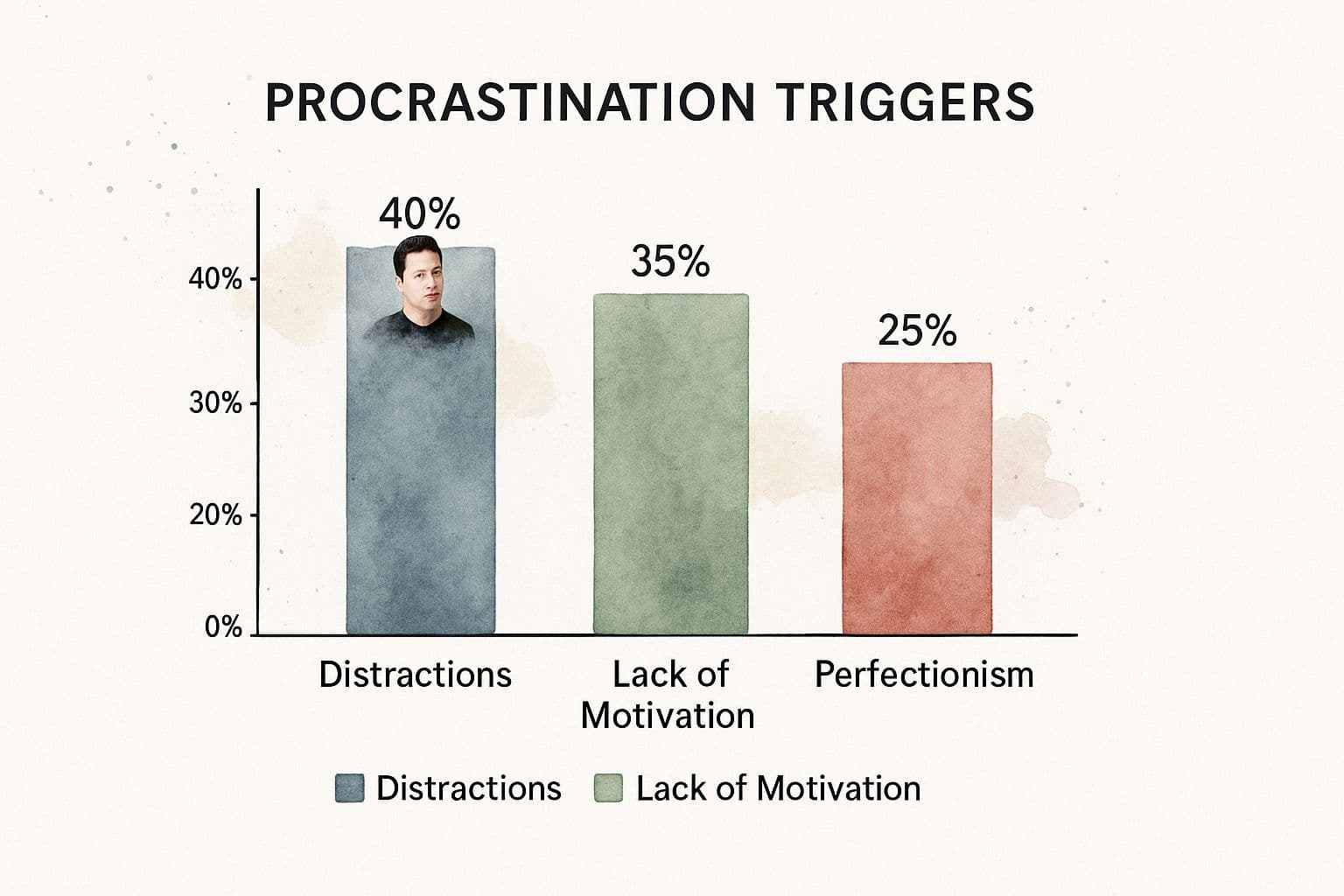Learn how to overcome procrastination with practical tips. Discover effective ways to build focus and turn ideas into action today.
Do less, be more with Fluidwave
Fluidwave combines smart task prioritization with an assistant marketplace — AI and human help, all in one productivity app.
August 26, 2025 (3mo ago)
How to Overcome Procrastination: Proven Strategies to Boost Productivity
Learn how to overcome procrastination with practical tips. Discover effective ways to build focus and turn ideas into action today.
← Back to blog
If you want to beat procrastination for good, the first step is to stop thinking of it as a time management problem. It's not. It's an emotional regulation issue**. We put things off to sidestep negative feelings like anxiety, boredom, or self-doubt. This isn't a flaw in your character; it’s a deeply human habit that requires a smart, compassionate strategy, not just more willpower.
Why We Really Procrastinate

Ever had a critical deadline looming, knew exactly what needed to be done, but suddenly found yourself alphabetizing the spice rack? You’re not alone, and it doesn't mean you're lazy. It's actually a pretty sophisticated (though unhelpful) psychological response to a task that’s making you uncomfortable.
At its core, procrastination is an avoidance strategy. Your brain is essentially trying to shield you from the stress or anxiety tied to a particular task. Pushing it off gives you a fleeting moment of relief, but that relief is a trap. It just kicks the can down the road, and the problem almost always gets bigger.
The Common Psychological Triggers
Most of us get stuck for similar reasons. A few core emotional triggers are notorious for fueling that cycle of delay. See if you recognize any of these in your own work habits.
- Perfectionism: The all-or-nothing mindset. The pressure to produce something flawless is so immense that starting feels impossible. It’s easier to do nothing than to do something imperfectly.
- Fear of Failure (or Success): Worrying about negative judgment or not meeting expectations can be paralyzing. On the flip side, sometimes we fear success because it comes with new, higher-stakes pressures.
- Task Aversiveness: Let's be honest—some tasks are just plain boring, difficult, or unpleasant. Our brains are hardwired to seek pleasure and avoid pain, so we naturally steer clear of work that feels like a slog.
- Feeling Overwhelmed: When a project looks like a mountain with no clear path to the summit, it’s natural to feel lost. This feeling makes it incredibly difficult to find a starting point, which is why inaction often wins. Learning how to retrain your brain to overcome inaction is key to breaking this pattern.
Your Environment Matters More Than You Think
Our physical surroundings have a massive impact on our focus. Think about working from home—the lack of structure, clear boundaries, and the accountability that comes with being in an office can make it far too easy to slip into avoidance.
The numbers back this up. Chronic procrastination affects a staggering 20–25% of adults globally. A recent survey found that 88% of employees admit to procrastinating for at least an hour every day. This habit is especially prevalent at home, where people waste an average of 1.12 hours daily on non-work activities.
The big shift happens when you reframe procrastination as an emotional challenge, not a personal failing. It’s not about brute-forcing your way through the work; it’s about figuring out how to make the work feel less threatening.
Getting to the bottom of these psychological roots is everything. Once you stop trying to just "power through" and start addressing the real reasons for the delay, you can finally build habits that stick. This mindset shift is a central idea in our guide on how to stop wasting time.
The Sneaky Ways Procrastination is Costing You
We've all been there. You put off a task, telling yourself it’s just for a little while. It feels like a harmless trade-off for a bit of relief right now. But chronic delay is a lot like a slow leak in a tire—you don't notice it at first, but eventually, you find yourself completely stranded. The real price of procrastination isn't a single missed deadline; it's a compounding tax on your time, career, finances, and even your mental health.
Every time you say, "I'll get to it tomorrow," you're making a small deposit into a growing debt of lost time. These tiny delays add up, snowballing into weeks of lost productivity and missed opportunities over the course of a year. It's how professional growth stalls, leaving you wondering why you're being passed over for that promotion or why it feels impossible to gain any real momentum.
The Professional and Financial Hit
This habit doesn't just stay at the office, either. Procrastination has a way of creeping into your personal finances, leading to late fees on bills, missed chances to invest, or just a general failure to get your money organized. It’s the constant, draining cycle of playing catch-up instead of planning ahead. These small delays create serious friction, making it that much harder to hit your long-term goals.
The numbers are pretty staggering when you look at them. On average, people lose about 1.59 hours every single day to procrastination. That adds up to a mind-boggling 55 days a year. Think about that—you’re losing nearly two full months of potential progress, year after year. It's a huge issue, especially for younger people. A study found that 81% of undergraduate students (ages 14 to 29) consider themselves habitual procrastinators. You can dig into more procrastination statistics to see just how widespread this is.
When you reframe procrastination from a vague bad habit to a concrete number—like losing two months of your life every year—it hits differently. It gives you a powerful reason to start reclaiming that time.
This chart breaks down the most common psychological triggers that keep us stuck.

As you can see, it's rarely about being lazy. The real culprits are things like distractions, feeling unmotivated, and the paralyzing fear of not doing something perfectly.
Procrastination's impact isn't just about work, either. It quietly chips away at our personal time, affecting relationships, health, and hobbies.
The Weekly Cost of Procrastination
| Area of Life | Percentage of Adults Affected | Average Time Lost Per Week |
|---|---|---|
| Work & Career | 78% | 4.5 hours |
| Personal Errands | 65% | 2.5 hours |
| Health & Fitness | 55% | 3 hours |
| Finances & Bills | 48% | 1.5 hours |
Seeing the hours add up across different parts of our lives makes it clear that this is more than just a work problem—it's a life problem.
The Burnout Cycle
Maybe the most insidious cost of all is what procrastination does to your mental well-being. Delaying a task isn't relaxing. It’s an incredibly active state of stress where you carry the weight of that unfinished work with you everywhere you go. It creates a constant, low-grade hum of anxiety in the background of your life.
This traps you in a vicious cycle that’s tough to break:
- You feel anxious about a big task, so you avoid it.
- Avoiding it gives you a fleeting sense of relief, but then guilt and stress start to build.
- The mounting pressure makes the task seem even bigger and more intimidating, which just reinforces your desire to avoid it.
This loop is a fast-track to burnout. It eats away at your self-esteem and makes it harder and harder to start anything. Understanding these high stakes is the first real step in figuring out how to overcome procrastination. This isn't just about productivity; it’s about getting your peace of mind back.
Practical Strategies to Reclaim Your Focus

Knowing why you procrastinate is one thing, but actually doing something about it is where the real change happens. It's time to shift from understanding the problem to building a practical toolkit you can use right away. These aren't just theories; they're proven techniques designed to break the cycle of avoidance and help you build momentum.
The trick isn't finding one perfect solution. It's about creating a system of reliable habits that work for you. Think of it as an experiment—by trying these methods, you'll discover what clicks with your personal workflow, finally turning that constant battle against procrastination into a more natural, productive rhythm.
Dismantle Overwhelming Projects with Micro-Tasks
Big, intimidating projects are procrastination's best friend. A task like "write the annual report" can feel so massive that you don't even know where to begin, which makes it easy to put off. The secret is to stop looking at the mountain and instead focus on breaking it down into a series of small, manageable hills.
This is the core idea of micro-tasking. Forget the huge, vague goal for a moment and define the absolute smallest first step you can take. This simple act reframes the entire project, shifting it from a source of anxiety to a simple action you can knock out in a few minutes.
Here’s how it looks in practice:
- Instead of: "Build new client presentation."
- Try: "Open a new slide deck and create a title slide."
- Instead of: "Clean the entire garage."
- Try: "Take one bag of trash out to the bin."
Each tiny completion gives your brain a little hit of dopamine, a reward that makes taking the next small step feel much easier. Momentum builds one micro-task at a time. To take this a step further, mastering strategies to prioritize tasks effectively will help you decide which small steps to tackle first.
Procrastination thrives on ambiguity and overwhelm. The best defense is to create absolute clarity on the very next, very small action required.
Make Starting Effortless with Simple Rules
Let's be honest, getting started is almost always the hardest part. But once you’re moving, it’s much easier to stay in motion. A couple of simple, non-negotiable rules can help you push through that initial resistance.
The Two-Minute Rule: Popularized by author David Allen, this rule is beautifully simple: if a task takes less than two minutes, do it immediately. Don't add it to a list, don't think about it later. Just do it. This prevents the pile-up of tiny to-dos that create mental clutter and a nagging sense of being behind.
The Pomodoro Technique: This classic time-management method is a game-changer for a reason. You work in focused bursts, traditionally 25 minutes long, with short breaks in between. It works because it provides a clear start and a clear finish line, making an intimidating block of work feel finite and manageable. For more ways to sharpen your concentration, our guide on how to focus at work has some powerful techniques.
Engineer Your Environment for Success
Your workspace sends constant signals to your brain. A cluttered desk in front of a TV is an open invitation for distraction. On the other hand, a clean, dedicated workspace tells your brain it's time to concentrate. Setting up a "distraction-free zone" isn't a luxury; it's a fundamental step in winning the war against procrastination.
Think about how you can reduce the friction between you and your most important work. A few small tweaks can make a huge difference:
- Clear Your Workspace: A tidy desk minimizes visual noise and removes the temptation to fiddle with things that aren't your task.
- Use Digital Tools: Get an app or browser extension that blocks distracting websites. A 25-minute work sprint is a lot more effective when you physically can't check social media.
- Signal Your Intent: Little rituals like putting on noise-canceling headphones, closing your office door, or switching your phone to "Do Not Disturb" prime your brain for deep work.
Use Automation to Sidestep Procrastination
We all have them. Those tasks on our to-do list that just seem to linger, getting pushed from Monday to Tuesday, then to Friday, then to "next week." They’re usually the repetitive, mind-numbing chores that suck the life out of your motivation.
Instead of fighting a daily battle of willpower, what if you could just… make them disappear? This is where smart automation comes in. It's not about being lazy; it's about being strategic. By offloading the tasks you're most likely to avoid, you save your mental energy for the work that actually matters—the creative, high-impact stuff that moves the needle.
Pinpoint Your Procrastination Triggers
Before you can build an automated system, you have to know what you're up against. Spend a few minutes looking at your typical week. What tasks do you consistently dread? Which ones always end up at the bottom of the list?
These are your prime candidates. Common culprits I see all the time include:
- Weekly Reporting: Pulling the same numbers and putting them into the same spreadsheet.
- Chasing People: Sending those "just following up" emails to clients or colleagues.
- Data Transfer: Copying and pasting information from your email to your CRM.
- Social Media Management: Manually posting the same update across five different platforms.
Once you’ve identified these friction points, you can start engineering a workflow that works for you, not against you. It's a powerful shift in mindset. For anyone putting off their next career move, learning how to effectively automate job applications is a perfect real-world example of this principle.
Delegate and Automate with the Right Tools
This is where a platform like Fluidwave really shines. It’s built not just to help you manage your work, but to help you eliminate the tedious parts of it.
Let's say you absolutely despise compiling your team's weekly progress report. It’s not hard, but it’s an hour of boring, repetitive work you'd rather spend doing literally anything else. With an automation tool, you can build a workflow to handle it automatically.
Here’s an example of the kind of clean, focused interface that makes setting this up a breeze.
The big idea here is that the best tools don't just give you a better list of things to do—they actively shorten that list for you.
By setting up an automated workflow or even delegating the task to a virtual assistant directly through the platform, you remove the procrastination trigger entirely. The report gets done, on time, every time. You no longer have to waste a single ounce of mental energy dreading it. If you want a deeper dive, we have a complete guide on how to automate repetitive tasks.
Automation is the ultimate cheat code for recurring tasks you procrastinate on. It solves the problem at its root by taking the task completely off your plate, freeing you up to focus on what’s important.
When you offload these monotonous duties, you get back more than just time. You reclaim valuable cognitive bandwidth. This frees you up to focus on strategic thinking, solving complex problems, and doing the engaging work you’re far less likely to put off in the first place. The result? A more productive, less stressful workday, all by design.
Designing a Procrastination-Proof Daily Routine

Winning a single battle against procrastination feels great, but the real victory is building a system that prevents the war from ever starting. This is all about crafting a daily structure so intentional that productivity becomes your default setting, not a constant struggle.
Forget relying on sheer willpower. The goal is to create a routine that automatically steers you toward focus. Instead of seeing your day as a wide-open field of time, you'll start treating it as a series of dedicated, purposeful blocks. This proactive approach lets you take control before distractions even get a foothold.
Build Your Day Around Time Blocks
Time blocking is a game-changer. It's the simple act of scheduling every part of your day, from deep work sessions to your lunch break. When you assign a specific job to every minute, you completely remove the mental gymnastics of deciding what to do next. That clarity is a powerful defense against the mindless scrolling that eats up unstructured time.
Think of it like a budget for your time. You're deciding ahead of schedule where your most valuable resource—your attention—is going to be spent.
For instance, a section of your calendar might look something like this:
- 9:00 AM - 9:30 AM: Clear out urgent emails.
- 9:30 AM - 11:30 AM: Deep work on "Project Alpha" (phone on silent, notifications off).
- 11:30 AM - 12:00 PM: Prep for afternoon meetings.
This gives you a clear roadmap for the day. You shift from making reactive decisions to proactively executing a plan you've already laid out.
Your routine is your best defense against procrastination. When you have a clear plan for your day, you spend less energy fighting distractions and more energy doing meaningful work.
Maximize Efficiency with Task Batching
Jumping from writing an email to analyzing a spreadsheet to making a phone call forces your brain to constantly shift gears. This "context switching" is a huge drain on your energy and focus. The solution? Task batching. It just means grouping similar activities together so you can stay in a state of flow.
When you batch your work, you handle all related to-dos in one concentrated session. This drastically cuts down on the mental "startup cost" of beginning each new activity.
Here are a few batches I use all the time:
- Communication Block: Knock out all emails, return calls, and check team messages in one dedicated hour.
- Creative Block: Set aside a two-hour window for nothing but brainstorming, writing, or design.
- Admin Block: Process invoices, schedule appointments, and organize files all at once.
This simple change keeps your brain locked into one mode of thinking, which can dramatically boost both your speed and the quality of your output.
Align Tasks with Your Energy Levels
Let's be honest, not all hours of the day are created equal. We all have times when we're firing on all cylinders and times when we feel like we're slogging through mud. The final piece of the puzzle is energy management—matching your most difficult tasks with your own biological prime time.
Are you sharpest in the morning? That's when you should tackle your most complex, creative projects. If you hit a wall after lunch, save that time for lower-stakes work like admin tasks or catching up on industry news.
By aligning your schedule with your natural energy rhythms, you're tackling your biggest challenges when you have the most mental fuel, which makes them feel far less intimidating from the start.
Still Have Questions? Let's Clear Things Up
As you start untangling your procrastination habits, a few questions are bound to surface. It's totally normal. Getting to the root of why we put things off is a huge part of the battle. Here are some straight answers to the questions I hear most often.
Thinking through these points helps shift your perspective. Instead of beating yourself up over a supposed lack of willpower, you can start building smarter systems that play to your brain's strengths.
"Am I Just Being Lazy?"
Not a chance. This is easily the biggest myth about procrastination, and frankly, believing it does more harm than good. From the outside, delaying a task might look like laziness, but on the inside, it's almost always an emotional reaction.
What’s really going on? It's often driven by deeper feelings:
- Anxiety about whether you'll succeed or fail.
- The fear of not getting it perfect (a classic perfectionist trap).
- Feeling completely swamped by the sheer scale of a project.
- Plain old boredom or a total lack of connection to the work.
When you start treating procrastination as an issue of managing emotions—not a personal failing—you'll find much more effective solutions. It's a defense mechanism, not a flaw in your character.
"Isn't Technology Just a Bigger Distraction?"
I get it—this is a classic double-edged sword. Your phone can absolutely be your biggest enemy when you're trying to focus. But used deliberately, the right tech can also be your most powerful ally. It all comes down to being strategic.
You can, for example, use apps and browser extensions to block the sites that pull you off track during deep work sessions. That’s about creating a focused digital space. On the flip side, you can lean on platforms like Fluidwave to automate or delegate the mind-numbing, repetitive tasks that you’re most likely to procrastinate on anyway. This frees up your brainpower for the meaningful work you actually want to do.
The single best thing you can do to get started is to break a big, scary task into its smallest possible piece. Don't think 'write the report.' Instead, make the first step 'open a new doc and title it.'
That tiny bit of forward motion is often all it takes to break the inertia and build unstoppable momentum for the next small step.
Ready to stop wrestling with your to-do list and build a system that works for you? See how Fluidwave can take tedious tasks off your plate through automation and delegation, freeing you up for hours of focused work every week. Get started for free today.
Do less, be more with Fluidwave
Fluidwave combines smart task prioritization with an assistant marketplace — AI and human help, all in one productivity app.